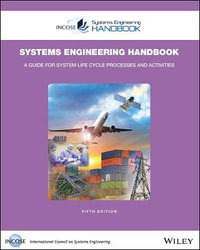
Sustainable Supply Chain Management
Sustainable Decision Support
By: Anicia Jaegler, Thierry Roques
Hardcover | 22 September 2023 | Edition Number 1
At a Glance
272 Pages
23.39 x 15.6 x 1.6
Hardcover
RRP $301.35
$248.80
17%OFF
or 4 interest-free payments of $62.20 with
orAims to ship in 7 to 10 business days
Transforming a supply chain to make it more sustainable and responsible often requires a considerable amount of time and resources. The aim of this book is to present a number of simple best practices that can reduce these negative impacts and make supply chains more virtuous.
Sustainable Supply Chain Management is a handbook for supply chain transformation. It explores the different facets of the supply chain, from product design or procurement to logistics operations management and performance. It offers a guide to actions for sustainable supply chain transformation, providing elements of the legal framework for possible actions and tools for measuring the performance that can be achieved.
Introduction xi
Chapter 1 Eco-design 1
1.1 What are we talking about? 1
1.2 Why is this so? 3
1.2.1 An economic challenge for the company 4
1.2.2 A commercial issue 4
1.2.3 A challenge for innovation 5
1.2.4 An image issue 5
1.2.5 A risk management issue 5
1.2.6 A challenge of internal mobilization 6
1.3 Institutional, legal and normative framework 6
1.3.1 Institutional framework 6
1.3.2 Legal framework 7
1.3.3 Normative framework 8
1.4 Best practices 9
1.4.1 Best practice 1: Implementing a product life cycle analysis 9
1.4.2 Best practice 2: Implementing an eco-design approach 12
1.4.3 Best practice 3: Eco-design of packaging 13
1.5 Measuring eco-design performance 14
Chapter 2 Buying Sustainably and Responsibly 17
2.1 What are we talking about? 17
2.2 Why? 18
2.2.1 Image enhancement with suppliers 18
2.2.2 Securing links with suppliers 19
2.2.3 Image enhancement and competitive advantage with customers 19
2.2.4 Better control of costs and profit 19
2.2.5 Better control of the regulatory environment 20
2.2.6 Value creation and innovation capture 20
2.3 Institutional, legal and normative framework for sustainable procurement 20
2.3.1 Institutional framework 20
2.3.2 Legal and regulatory framework 22
2.3.3 Normative framework 24
2.4 Best practices 25
2.4.1 Best practice 1: Carrying out a diagnosis of purchasing processes from a sustainable perspective 26
2.4.2 Best practice 2: Creating a sustainable and responsible purchasing strategy 35
2.4.3 Best practice 3: Drawing up a responsible purchasing charter 38
2.4.4 Best practice 4: Writing sustainable and responsible specifications 40
2.4.5 Best practice 5: Implementing a total cost of ownership (TCO) procurement approach 43
2.5 Measuring the performance of sustainable and responsible purchasing 45
Chapter 3 Sustainable Management 51
3.1 What are we talking about? 51
3.2 Why is this so? 52
3.2.1 Attracting and retaining supply chain talent 52
3.2.2 Fighting against discrimination 52
3.2.3 Promoting overall performance 52
3.3 Institutional, legal and normative framework 53
3.3.1 Institutional framework 53
3.3.2 Legal framework 55
3.3.3 Normative framework 56
3.4 Best practices 58
3.4.1 Best Practice 1: Implementing environmental management 58
3.4.2 Best Practice 2: Implementing an inclusion model 59
3.5 Measuring the performance of sustainable management 61
Chapter 4 Sustainable Storage 69
4.1 What are we talking about? 69
4.2 Why is this so? 70
4.3 Legal framework and certifications of the sustainable warehouse 71
4.3.1 Legal framework 72
4.3.2 Regulatory framework 73
4.3.3 Social regulations in the warehouse 76
4.3.4 Certifications and labels 77
4.4 Best practices 80
4.4.1 Best practice 1: Managing stormwater and wastewater on the warehouse right-of-way 81
4.4.2 Best practice 2: Optimizing and improving warehouse space 83
4.4.3 Best practice 3: Reducing energy consumption in the warehouse 88
4.4.4 Best practice 4: Recycling warehouse packaging and waste 95
4.4.5 Best practice 5: Making the warehouse a safe and pleasant place to work 97
4.5 Measuring the performance of the sustainable warehouse 102
4.5.1 Best practice 1: Managing stormwater on the warehouse right-of-way 103
4.5.2 Best practice 2: Optimizing and improving warehouse space 103
4.5.3 Best practice 3: Reducing energy consumption in the warehouse 105
4.5.4 Best practice 4: Recycling packaging and waste from the warehouse 105
4.5.5 Best practice 5: Making the warehouse a safe and pleasant place to work 106
Chapter 5 Packaging in a Sustainable Way 111
5.1 What are we talking about? 111
5.2 Why is it important to change to a sustainable and responsible approach to product packaging? 112
5.2.1 Factors amplifying the carbon footprint and waste for packaging 112
5.2.2 Factors amplifying the carbon footprint and waste for primary packaging 114
5.3 Institutional, legal and normative framework for sustainable packaging 115
5.3.1 Institutional framework 115
5.3.2 Legal framework 116
5.3.3 Normative framework 118
5.4 Best practice 120
5.4.1 Best practice 1: Optimizing packaging 121
5.4.2 Best practice 2: Using sustainable materials 123
5.4.3 Best practice 3: Implementing a policy of reusing packaging 126
5.4.4 Best practice 4: Implementing a packaging recycling policy 129
5.4.5 Best practice 5: Sustainable packaging: Eco-design of packaging 131
5.4.6 Best practice 6: Sustainable packaging: Consolidating orders and packaging 131
5.4.7 Best practice 7: Sustainable packaging: Designing packaging to facilitate customer returns 132
5.4.8 Best practice 8: Sustainable packaging: Designing packaging for diverted use 132
5.5 Measuring the performance of sustainable packaging 132
Chapter 6 Implementing Reverse Logistics 139
6.1 What are we talking about? 139
6.2 Why is this so? 142
6.2.1 Legal issues 142
6.2.2 Economic issues 142
6.2.3 Logistical issues 143
6.3 Institutional, legal and normative framework 143
6.3.1 Institutional framework 143
6.3.2 Legal and regulatory framework 144
6.3.3 Normative framework 145
6.4 Best practices 146
6.4.1 Best practice 1: Creating an ecosystem 146
6.4.2 Best practice 2: Implementing reverse logistics 147
6.4.3 Best practice 3: Facilitating the return of e-commerce products 150
6.4.4 Best practice 4: Implementing a filter process for after-sales service for repairs 151
6.4.5 Best practice 5: Deploying preventive maintenance 151
6.4.6 Best practice 6: Optimizing the recycling of end-of-life products 152
6.5 Measuring the performance of the reverse supply chain 153
Chapter 7 Transporting in a Sustainable Way 159
7.1 What are we talking about? 159
7.2 Why is it important to choose a sustainable and responsible approach to freight transport? 160
7.3 Institutional, legal and normative framework for sustainable transport 161
7.3.1 Institutional framework 161
7.3.2 Legal framework 163
7.3.3 Normative framework 165
7.4 Best practices 166
7.4.1 Best practice 1: Reorganizing networks and choosing the most sustainable modes 166
7.4.2 Best practice 2: Optimizing routing and increasing shipments 168
7.4.3 Best practice 3: Optimizing loads 171
7.4.4 Best practice 4: Prioritizing the least greenhouse gas emitting modes of transport 173
7.4.5 Best practice 5: Managing the last mile 176
7.5 Measuring sustainable transportation performance 180
7.5.1 Measuring the environmental performance of transportation 181
7.5.2 Measuring the social performance of transportation 183
Chapter 8 Certifying the Supply Chain 185
8.1 What are we talking about? 185
8.2 Why certify your supply chain in a sustainable way? 186
8.2.1 Certification as a means to improve transparency on the impact of supply chains on their ecosystems 186
8.2.2 Certification as part of the strategic roadmap towards virtuous and sustainable supply chains 187
8.2.3 Certification -- a risk-limiting mechanism 188
8.2.4 Certification as a tool for internal and external communication 188
8.3 Institutional, legal and normative framework for certification in the context of a sustainable supply chain 189
8.3.1 Institutional framework, certifying bodies 189
8.3.2 Legal framework 192
8.3.3 Normative framework 194
8.4 Best practices for sustainable supply chain certification 195
8.4.1 Best practice 1: Implementing a sustainable supply chain certification process 195
8.4.2 Best practice 2: Finalizing the sustainable supply chain certification process 201
8.5 Measuring the performance of the certification process 203
Chapter 9 Improving Performance 205
9.1 What are we talking about? 205
9.2 Why is this so? 206
9.3 Institutional, legal and normative framework 207
9.3.1 Greenhouse gases 207
9.3.2 Water 210
9.3.3 Biodiversity 211
9.3.4 Waste 212
9.4 Best practices 213
9.4.1 Best practice 1: Implementing a decarbonization strategy 214
9.4.2 Best practice 2: Deploying a dashboard to monitor the sustainable transformation of the supply chain using Business Intelligence 218
9.5 Measurement indicators 220
Conclusion 225
Appendix 227
References 233
Index 235
ISBN: 9781786307422
ISBN-10: 1786307421
Series: Systems and Industrial Engineering
Published: 22nd September 2023
Format: Hardcover
Language: English
Number of Pages: 272
Audience: Professional and Scholarly
Publisher: John Wiley & Sons Inc (US)
Country of Publication: GB
Edition Number: 1
Dimensions (cm): 23.39 x 15.6 x 1.6
Weight (kg): 0.65
Shipping
| Standard Shipping | Express Shipping | |
|---|---|---|
| Metro postcodes: | $9.99 | $14.95 |
| Regional postcodes: | $9.99 | $14.95 |
| Rural postcodes: | $9.99 | $14.95 |
How to return your order
At Booktopia, we offer hassle-free returns in accordance with our returns policy. If you wish to return an item, please get in touch with Booktopia Customer Care.
Additional postage charges may be applicable.
Defective items
If there is a problem with any of the items received for your order then the Booktopia Customer Care team is ready to assist you.
For more info please visit our Help Centre.
You Can Find This Book In

INCOSE Systems Engineering Handbook
5th Edition - A Guide for System Life Cycle Processes and Activities
Paperback
RRP $149.95
$92.50
OFF






















